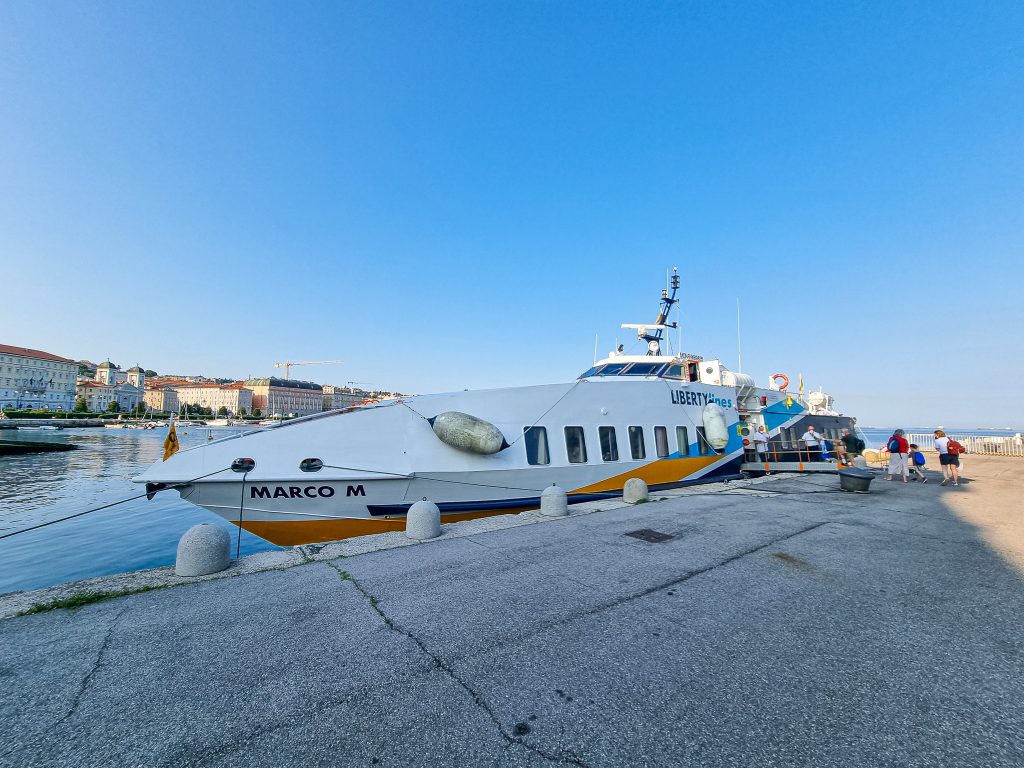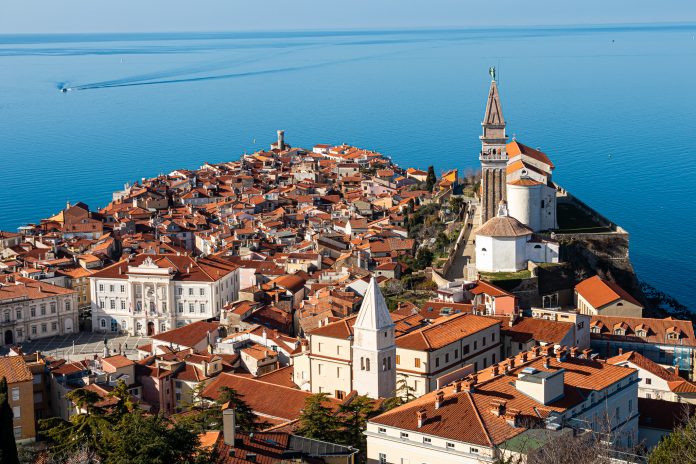Words and photography: Victor Caneva
Summer is here and for my family that means one thing: my boys want to go to the beach! Hoping to surprise the kiddos with an epic beach day, we spontaneously booked a ferry from Trieste to Rovinj (Rovigno in Italian), a historic gem in Croatian Istria, which boasts several Blue Flag beaches.
We’ve always wanted to take these ferries operated by Liberty Lines which run from late May to early September, but because of the pandemic we’d never had the chance to take advantage of this perk of living in Trieste.

Several ferries are available every week from Trieste to Piran in Slovenia and Poreč, Rovinj, and Mali Lošinj in Croatia, providing Trieste residents a scenic way to enjoy the stunning geographical and cultural diversity that surrounds us without driving. Apart from Mali Lošinj (Lussinpiccolo in Italian), all these locations are in Istria.
Blessed with a gloriously sunny day, the waters around Rovinj sparkled like sapphires as we swam, strolled along the bustling harbor with a gelato, and ate ćevapčići in the charming historic center of town. We returned to Trieste (and Italy) tired, sunburnt, and satisfied after a long day of fun. This unexpected jaunt to Istria got me thinking – how has Trieste’s proximity to Istria shaped its identity over the centuries?

Trieste and Istria have always had a complicated relationship. Lying just to the south of Trieste, Istria, the largest peninsula on the Adriatic which comprises a sliver of Italy, part of Slovenia, and a substantial chunk of Croatia, is complex by nature.
I challenge you to try to summarize “Istrian Culture” in one or two sentences. You’ll start out with seemingly adequate ideas about brandy, hill-towns, and Venetian influence, but end up feeling that you are walking a tenuous tightrope of cultural sensitivities.
Throughout the ages Trieste and Istria have been enemies and allies, parts of competing and common kingdoms. Today, the Province of Trieste is home to the only two Italian settlements on the peninsula, Muggia and San Dorligo della Valle (or Dolina). Although they are now only a short bus or ferry ride away from Trieste’s center, for centuries these towns were the enemy – hostile Venetian outposts on the border of Habsburgian Austria. As Venetian influence waned, they were incorporated into the Austrian Empire along with the rest of Istria. Pula (or Pola) in the south of Istria became Austria’s naval headquarters while Trieste served as the empire’s preeminent port.

Trieste’s position as a political and cultural crossroads gives it a flair like no other city, but it also complicates the heck out of its history. The same can be said of Istria, which was regularly divided among competing world powers and boasted sizeable Italian and Slavic-speaking populations (along with other minorities). Sadly, at times divergent powers and movements exploited differences between these peoples, who also shared periods of peaceful coexistence, for their own ends.
During the later stages of the Austrian Empire, Italian irredentist movements sprang up in both Trieste and Istria. In response, Austrian Emperor Franz Joseph I instituted a policy of Germanization or Slavization in areas of the empire with Italian influence. Conversely, when Trieste and Istria became parts of Italy after World War I, Slavic languages were banned under a fascist regime of Italianization.
As the Second World War raged, Trieste and Istria became a battleground not only between the Allies and the Axis Powers, but between the ideologies of communism and fascism. Tragically, during and after the war when most of Istria became part of the new communist state of Yugoslavia, the conflict between these philosophies at times devolved into ethnic rivalry, producing festering wounds on the region’s Italian and Slavic populations.
One of these wounds that has dramatically influenced Trieste is the Istrian-Dalmatian Exodus. After experiencing various forms of oppression, which were sometimes violent, thousands of Italian-speaking residents of Istria and other areas of Yugoslavia left their homes and moved to Italy from 1943 to 1960. Many of these Istrian Italians settled in Trieste, leaving an indelible mark on the city. Trieste is the headquarters of the Regional Institute for Istrian, Dalmatian, and Fiumian Culture which runs a museum and exhibition regarding the Italian exiles from Istria, Dalmatia, and Fiume.
This period of history is so controversial that the curious will be frustrated as they find wildly different estimates of how many Italians fled Istria and competing narratives as to why they left. What is certain, however, is that there are significantly fewer Italian speakers living in Istria than there were a generation ago and many of the descendants of those who left now call Trieste home.
In Trieste we get to experience the richness of a host of cultures blending to create a truly unique cultural milieu and Istrian influences are certainly part of the intoxicating mix. When you see bottles of pelinkovac, a bitter wormwood-based liquor on the shelves of a Trieste bar, you are experiencing a bit of Istria in Trieste. If you order branzino (sea bass) in Trieste, there’s a good chance you will be feasting on an Istrian product. Do you appreciate fine olive oil? Then you must try some oil made from the uniquely Istrian bianchera olive tree, which produces some of the most acclaimed olive oils around.
Istria may be a hard place to describe culturally, but it isn’t hard to explain why people love to visit it. Stunning beaches, ancient castles, Venetian bell towers, and idyllic hill towns all lie just to the south of Trieste. As the world opens, I encourage you to jump in a car, on a bus, or on a ferry and discover this enchanting part of the world for yourself.






























Grazie, for Article on Istria and Trieste, wow, what a interesting Cultural Milieux.